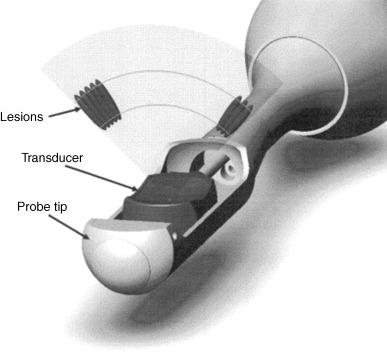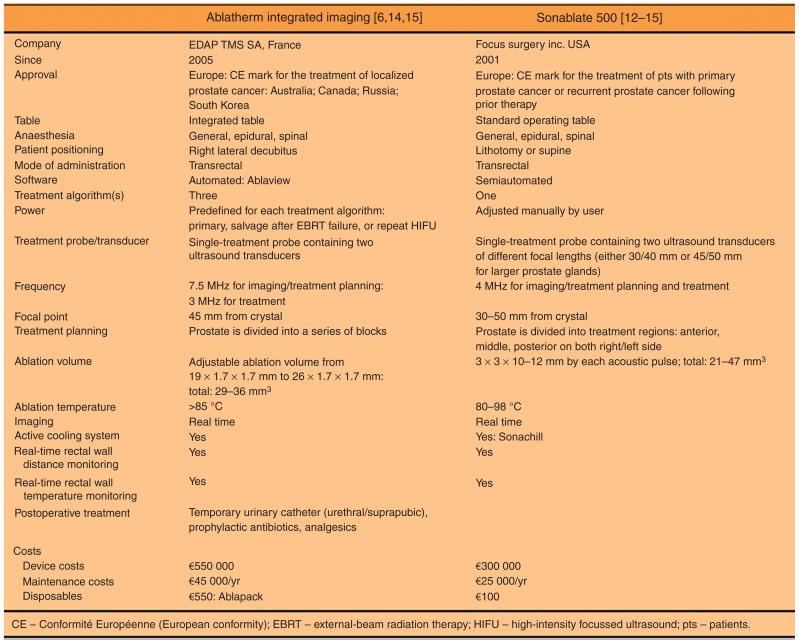Physical Address
304 North Cardinal St.
Dorchester Center, MA 02124
Increases in prostate cancer (PCa) screening due to the widespread use of prostate-specific antigen (PSA) has resulted in the diagnosis of more focal and clinically insignificant prostate adenocarcinomas. Active surveillance is often offered as an option for managing carefully selected patients with low-volume disease; however, guidelines for selecting which men should qualify have not been widely accepted or implemented. Studies have suggested that there can be significant psychological distress associated with watchful waiting, even with low-risk tumors. Alternatively, radical therapies for localized prostate cancer (PCa) such as radiotherapy and radical prostatectomy are known to impact patients’ quality of life, specifically urinary continence and sexual function. High-Intensity Focused Ultrasound (HIFU) has been proposed as an alternative method of treating localized PCa with a potentially lower side effect profile than radiotherapy or radical prostatectomy. HIFU is also being utilized in patients who require definitive therapy but may not be surgical candidates and as salvage therapy following recurrence after radical prostatectomy or radiotherapy. Advantages to HIFU therapy include minimal bleeding, reduced risk of infection, procedural simplicity, and repeatability.
HIFU, like cryoablation, is one of the more common forms of thermal therapy that is currently being utilized in PCa management. Whereas cryoablation utilizes extreme cold to destroy tissue, HIFU uses intensely focused sound waves to burn it. HIFU was pioneered for the management of benign prostatic hypertrophy (BPH) in the 1990s. However, due to its side effect profile and the availability of alternative minimally-invasive procedures and holmium laser enucleation or ablation of the prostate, the use of HIFU for BPH has not become widespread. Ohigashi et al. compared the efficacy of HIFU with transurethral needle ablation (TUNA) and transurethral microwave therapy (TUMT) for treating lower urinary tract symptoms (LUTS) and reported no differences in efficacy or long-term durability between the three therapies. Despite the limited interest in using HIFU to treat BPH, the procedure is gaining popularity in other areas of urology as well as in other surgical fields. HIFU has recently been used for the management of small renal tumors, and it has carried FDA approval for the treatment of uterine fibroids since 2004.
HIFU technology works by focusing high-energy (3–4 MHz) ultrasound waves emitted in a parabolic arrangement such that they converge onto a discrete region of tissue, the focal point ( Figure 59.1 ). Ultrasound energy is absorbed at the focus, heating the tissue to temperatures in the range of 80–100°C. The characteristics of the tissue being destroyed, such as its size, shape, and absorption coefficient, as well as the duration of exposure together determine the thermal dose. Thermal doses above the necessary threshold cause coagulative-tissue destruction, ultimately leading to local tissue necrosis. Intensity of the beam is adjusted to fall above the heat threshold for the tissue but below the point where cavitation occurs. In cavitation, negative pressure formed by the ultrasound wave leads to air bubbles forming within the cells. These bubbles oscillate in size and shape with the changing pressures caused by incoming ultrasound waves until they eventually collapse, creating a shockwave that destroys the surrounding cells. Through this process, sharply demarcated lesions are created whereby the border between HIFU ablated and non-HIFU ablated cells is only 5–7 cell layers thick, and no damage to intervening tissue was observed.

There are currently two HIFU devices commercially available, Ablatherm Integrated Imaging ® (Edap Technomed, Vaulx-en-Velin, France) and Sonablate 500 ® (Focus Surgery, Indianapolis, IN, USA). These devices access the prostate gland via insertion of an ultrasound probe into the rectal vault. Ultrasound waves pass through rectal tissue with only minimal tissue change occurring outside the desired treatment area. Some rise in temperature outside the focal point does occur, and trials using early versions of the devices report complications of rectal burns and perforations. Newer versions mitigate this risk by using cooled, degassed fluid as a coupling medium to surround the probe and cool the rectal wall. Real time rectal wall temperature, distance monitoring, ability to automatically detect patient movement, and pause treatment serve as safety features to protect surrounding tissue.
To begin the procedure, the patient is placed in the right lateral decubitus position for the Ablatherm and in lithotomy or supine for Sonablate. The device is lubricated and inserted into the rectum, providing access to the prostate gland for pretreatment imaging. Serial cross sectional images of the prostate are then obtained in order to define the shape of the prostate and surrounding landmarks. The resulting 3D computer reconstruction is used by the surgeon to program the device and define the treatment area. The prostate is then sequentially destroyed using HIFU beams targeted to an area with lesions similar in size to a grain of rice. By intentionally following a noncontiguous pattern of focus, the device limits buildup and spread of thermal energy and allows surrounding tissue to cool down. This allows highly precise and focused destruction of prostate tissue. Power level must be adjusted based on the characteristics of the tissue, accounting for patient history of external beam radiation or previous HIFU and the distance between the rectal wall and probe. Real time imaging allows intraoperative adjustment that may be necessary to account for patient movement or whole-prostate swelling. In the newest version of the Sonoblate device, acoustical imaging changes in the treatment zone and surrounding tissue are continuously monitored to detect energy absorption. Significantly, focal length and ablation volumes vary between devices ( Figure 59.2 ) and must be modified to account for prostate size.

Biermann et al. examined the histopathologic findings of biopsies taken 6 months post-HIFU. A majority of biopsies demonstrated coagulative necrosis, stromal fibrosis, and evidence of both acute and chronic inflammatory changes. Similarly, Madersbacher et al. found that HIFU ablated tissue exhibits classic coagulative necrosis within 7 days of treatment and by 10 weeks, the coagulative necrosis is resorbed and replaced by scar. The resulting destruction to identifiable prostate architecture following treatment with HIFU raises concerns about potential difficulties in the identification of residual and recurrent PCa upon subsequent biopsy. As studied by Biermann et al., 44% of the HIFU ablated glands revealed residual prostate adenocarcinoma, and interestingly 82% of those biopsies that had adenocarcinoma did not show any evidence of HIFU treatment effect, making accurate identification of residual disease of the utmost importance. Recently, Walter et al. reported that AMACR and MIB-1 stains most reliably differentiate carcinoma from necrosis in early HIFU biopsy samples, and they may be useful for differentiating between residual carcinoma and HIFU related architectural changes. Additionally, Van Leenders et al. previously reported that HIFU lesions are marked by loss of cytokeratin 8 as compared to tissue that had not been ablated. Although more challenging, accurate interpretation of post-HIFU biopsy samples is feasible.
Despite over a decade of experience with HIFU for the treatment of localized PCa, appropriate selection of patients to undergo HIFU therapy remains an unrealized goal. Definitions of patients deemed eligible for HIFU therapy vary between countries and institutions. For example, the University College London Trials Unit definition for patients eligible for HIFU includes a life expectancy of at least 5 years, PSA ≤ 15 ng/mL, imaging or transperineal biopsy demonstration of stage T1-2N0M0 disease, and biopsy Gleason ≤ 7. Alternatively, French guidelines recommend HIFU as therapy in patients who are at least 70 years old with T1-T2N0M0 disease, PSA < 15 ng/mL, Gleason score < 7, and prostate volume < 40 mL. Of note, in 2010 Ontario’s Program in Evidence Based Care chose to not recommend HIFU as an alternative to accepted curative approaches.
Relative contraindications to HIFU are less controversial and include prostate volume > 40 mL and stricture or stenosis that would prevent an instrument from being introduced into the rectum. Prostate sizes > 40 mL increase the likelihood that portions of the periphery of a gland lie outside the device’s treatment area. It has been suggested that this challenge can be mitigated with pre-HIFU TURP or androgen deprivation therapy (ADT). However, Uchida et al. reported that use of neoadjuvant hormonal therapy did not lead to a significant reduction in treatment failure. When performing HIFU as a salvage therapy, shrinking of the prostate that occurs within the first 6 months following initial HIFU or radiation therapy brings the entirety of the gland within the device’s treatment radius and diminishes the effect that prostate size has on the likelihood of complete tumor eradication.
Become a Clinical Tree membership for Full access and enjoy Unlimited articles
If you are a member. Log in here